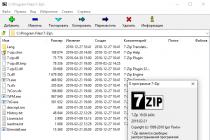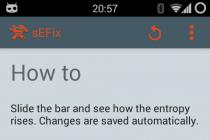Wandering through forums and all sorts of sites dedicated to Android, we constantly come across tips on how to increase the performance of your smartphone. Some recommend enabling swap, others - add special values to build.prop, and still others - change Linux kernel variables. You can find a huge amount of this kind of recipes in different versions, both on the XDA and on w3bsit3-dns.com. But do they really work?
Introduction
Having used a wide variety of * nix systems over the past ten years, I have always been amazed at how persistently some seemingly literate smartphone users are trying to push the public with their ideas for the optimal configuration of Android and the underlying Linux kernel. And it would be fine if the matter was limited to easy tuning of the virtual memory management subsystem or the inclusion of experimental options. No, usually we are offered to use long scripts that change literally every kernel variable, remount filesystems with various strange options, including swap, activate various system daemons and perform billions of other operations.
No, well, you can, of course, assume that the Linux kernel, Android and proprietary firmware for smartphones are developed by illiterate idiots whose work needs to be radically redone, but in practice for some reason it turns out that the most famous tuning tools published on XDA are nothing more than a team hodgepodge of a huge number of disparate recommendations, invented by someone who is not clear and who knows why. The absurdity of the situation comes to the fact that in these tools you can find strings copied from scripts without changes to increase the performance of a Linux server under high loads (I'm not kidding, take a look at the contents of the famous ThunderBolt script!).
In general, the situation is more than confusing. Everyone advises everything, no one advises anything, and those who understand something sit and, drinking tea, laugh at the happening booth. But let's try to clean up all this mess.
Swap
Let's start with swap, the most absurd idea you can think of for smartphones. Its meaning is to create and connect a paging file, due to which it will be possible to free up useful space in RAM. The idea itself, of course, is sensible, but only if we are talking about a server, which interactivity does not rest anywhere. On a smartphone, a regularly used paging file will lead to non-illusory lags arising from cache misses - just imagine what would happen if the application tries to display one of its icons, and it ends up in a swap, which will have to be loaded from disk again, having previously freed up space by Swaping data from another application. Horror.
Some users may argue that in fact, after turning on swap, no problems arise, but for this we need to thank the lowmemorykiller mechanism, which regularly kills especially bloated and not used applications for a long time. Thanks to it, a device with 1 GB of memory may never come to the need to dump data into a swap. It is also the reason why, unlike the Linux desktop, swap is not needed in Android.
Verdict: a very stupid idea, the implementation of which is fraught with serious lags.
zRAM
Swap is really very slow, and even on a desktop, its existence is often unjustified, but what if you cheat the system? Let's create a virtual disk directly in RAM with a built-in data compression function, connect it as a swap - and voila. The data compression feature is quite cheap even for modern mobile processors, so we can expand the size of the RAM with little or no performance loss.
The idea is so correct that even Google recommends using zRAM for KitKat-based devices if the amount of RAM does not exceed 512 MB. The only catch is that the method works only for modern state employees, that is, devices based on multi-core budget chips from some MTK and 512 MB of RAM. In this case, the encryption stream can be taken out on a separate core and not worry about performance at all.
On outdated devices with one core, for which "forum gurus" recommend the use of this technology, we will again get lags, and in a fairly large number. The same, by the way, applies to the KSM technology (Kernel SamePage Merging), which allows you to merge the same memory pages, thus freeing up space. It is also recommended by Google, but on older devices it leads to even greater lags, which is quite logical, given the constantly active nuclear flow, which continuously walks through memory in search of duplicate pages (are there really so many of these duplicates?).
Verdict: device dependent, slows down the system in most cases.
Seeder
At one time, this application made a lot of noise and gave rise to many analogs. A huge number of messages appeared on the web about the allegedly phenomenal increase in the performance of the smartphone after its installation. Homebrew builders of custom firmware began to include it in their builds, and the author was declared a savior. And all this despite the fact that Seeder did not perform any dirty hacks, but just fixed one stupid Android bug.
In short, the bug was that some high-level components of the Android runtime actively used the / dev / random file to obtain entropy / salt. At some point, the / dev / random buffer was emptied, and the system was blocked until it was filled with the required amount of data. And since it was filled with what came from different sensors, buttons and sensors of the smartphone, it took so much time for this procedure that the user had time to notice the lag.
To solve this problem, the author Seeder took the Linux daemon rngd, compiled it for Android, and configured it to take random data from the much faster (but also much more predictable) / dev / urandom and merge it into / dev / random every second. without letting the latter get depleted. As a result, the system never lacked entropy and worked quietly.
This bug was fixed by Google back in Android 3.0, and, it would seem, we do not need to remember Seeder. But the fact is that the application has been actively developed since then and even today is recommended by many "experts" for use. Moreover, the application has several counterparts (for example, sEFix), and many script / acceleration tool builders still include similar functionality in their creations. Sometimes it's the same rngd, sometimes it's the haveged daemon, sometimes it's just a symlink from / dev / urandom to / dev / random.

Everyone who has tried it is vying with each other about the effectiveness of the solution, however, according to Ricardo Cerqueira from Cyanogen, in modern versions of Android / dev / random is used by only three components: libcrypto (for encrypting SSL connections, generating SSH keys and etc.), wpa_supplicant / hostapd (for generating WEP / WPA keys), and several libraries for generating random IDs when creating ext2 / 3/4 filesystems.
The effectiveness of the application in modern Android, in his opinion, is not at all connected with the replenishment of the / dev / random pool, but with the fact that rngd constantly wakes up the device and forces it to increase the processor frequency, which has a positive effect on performance and negatively on the battery.
Verdict: Placebo.
Odex
Stock firmware of smartphones is always dressed up. This means that along with the standard Android application packages in APK format, the / system / app / and / system / priv-app / directories (starting with KitKat) also contain the files of the same name with the odex extension. They contain the so-called optimized application bytecode, which has already passed through the verifier and optimizer of the virtual machine and written into a separate file (this is done using the dexopt utility).
The meaning of the existence of odex files is to unload the virtual machine and thus speed up the launch of applications (stock). On the other hand, odex files prevent modifications to the firmware, create problems with updating, and for this reason many custom ROMs (including CyanogenMod) are distributed without them. You can return (more precisely, generate) odex files in different ways, including using simple utilities / scripts like the Odexer Tool. They are easy to use, and many "experts" advise doing so.
The only problem is that this is the purest placebo. Not finding odex files in the / system directory, the system will create them on the next boot and place them in the / system / dalvik-cache / directory. This is what she does when, when loading a new firmware, the message "Optimizing applications ..." appears on the screen. In relation to applications from the market, this also works, by the way. But at the stage of installing the software.
Verdict: Placebo.
Tweaks lowmemorykiller
Android's multitasking implementation is very different from other mobile operating systems and is based on the classic model. Applications can work quietly in the background, there are no restrictions on their number in the system, and functionality is not cut down when switching to background execution. Everything is like on a desktop, except for one detail: the system has every right to kill any background application in the event of a lack of RAM or (starting with KitKat) the application is excessively greedy for resources.
This mechanism, called lowmemorykiller, was invented so that, while retaining the features of a full-fledged multitasking OS, Android can live normally in conditions of limited memory and the absence of a swap partition. The user can safely launch any applications and quickly switch between them, and the system itself will take care of the completion of long-unused applications and so that there is always free memory in the device.
In the early years of Android, the purpose of this mechanism for many users was incomprehensible, so the so-called task killers became popular - applications that wake up from time to time and terminate all background applications. In this case, a large amount of free RAM was considered a profit, which was perceived as a plus, although, of course, there were no pluses in this. But there were many drawbacks in the form of longer switching between applications, increased battery consumption and problems with waking the owner in the morning (the alarm was also killed).
Over time, an understanding of the principles of multitasking came, and task killers were gradually abandoned. However, they were quickly replaced by another trend - tuning the lowmemorykiller mechanism itself (for example, using the MinFreeManager application). The main idea of the method is to raise the limits of filling the RAM, upon reaching which the system will start killing background applications. A kind of "both us and you" method, which allows you to free up a little memory by standard means, without breaking the ideas of Android multitasking.
But what does this ultimately lead to? Let's say the standard values of the memory filling boundaries are 4, 8, 12, 24, 32 and 40 MB, that is, when the free memory capacity of 40 MB is reached, one of the cached applications will be killed (loaded in memory, but not running, this is such an Android optimization ), with 32 - a Content Provider that does not have clients, 24 - one of the rarely used background applications, then application service processes (for example, a music player service) visible on the application screen and the currently running application are consumed. The difference between the latter two is that "current" is the application that the user is currently dealing with, and "visible" is something that, for example, has a notification in the status bar or displays some information on top of the screen.
In general, all this means that the smartphone will always have 40 MB of free memory, which is quite enough to accommodate another application, after which the LKM stream will wake up and start clearing the memory. Everyone is OK, everyone is happy. The system uses memory to the maximum. Now let's imagine what will happen if the user takes the advice of a homebrew "expert" and raises these values so that the latter will be, well, let's say, 100 MB (usually only the last three values are increased). In this case, one simple thing will happen: the user will lose 100 - 40 = 60 MB of device memory. Instead of using this space to store background apps, which is useful because it reduces switching time and battery life, the system will leave it free for some reason.
In fairness, it should be said that tuning LKM can be useful for devices with very little memory (less than 512) and Android 4.X on board or for a temporary increase in thresholds. Some tweak developers directly recommend using "aggressive" settings only in case of running heavy software like hi-end games, and staying on standard ones the rest of the time. It really makes sense.

Verdict: Better not to touch.
Tweaks I / O
In scripts published on the forums, you can often find tweaks to the I / O subsystem. For example, in the same script ThunderBolt! there are the following lines:
Echo 0> $ i / queue / rotational; echo 1024> $ i / queue / nr_requests;
The first one lets the I / O scheduler know that it is dealing with a solid-state disk, the second increases the maximum I / O queue size from 128 to 1024 (the $ i variable in the commands contains the path to the block device tree in / sys, for example / sys / block / mmcblk0 /, the script loops through them). Further in the text, you can find the following lines related to the CFQ scheduler:
Echo 1> $ i / queue / iosched / back_seek_penalty; echo 1> $ i / queue / iosched / low_latency; echo 1> $ i / queue / iosched / slice_idle;
Then there are a few more lines related to other schedulers (by the way, pay attention to the completely extra semicolons at the end of the commands). What's wrong with all these lines? The first two commands are meaningless for two reasons:
- The I / O schedulers in the modern Linux kernel are themselves able to figure out what type of media they are dealing with.
- Such a long I / O queue (1024) is completely pointless on a smartphone. Moreover, it is meaningless even on a desktop and is used on highly loaded servers (from the recommendations for configuring which, apparently, it got into this script).

The last three are meaningless for the simple reason that for a smartphone, where there is virtually no prioritization of applications for I / O and no mechanical drives, the best scheduler is noop, that is, a simple FIFO queue - whoever accessed memory first received access. And this scheduler does not have any special settings. Therefore, it is better to replace all these multiscreen lists of commands with one simple loop:
For i in / sys / block / mmc *; do echo noop> $ i / queue / scheduler echo 0> $ i / queue / iostats done
In addition to enabling the noop scheduler, it disables the accumulation of I / O statistics for all drives, which should also have a positive effect on performance (although this is just a drop in the ocean that will be completely invisible).
Another tweak that can often be found in performance tuning scripts is increasing the readahead value for the memory card to 2 MB. The readahead mechanism is designed to proactively read data from the media even before the application requests access to this data. If the kernel sees that someone has been reading data from the media for a long enough time, it tries to figure out what data the application will need in the future and loads it into the RAM in advance, thus reducing the time it takes to send it back.
It sounds cool, but, as practice shows, the readahead algorithm is very often mistaken, which leads to unnecessary I / O operations and a waste of RAM. High readahead values (1–8 MB) are recommended for use on RAID arrays, while on a desktop or smartphone it is better to leave everything as it is, that is, 128 KB.

Verdict: Except for noop, nothing is needed.
Virtual memory management system tweaks
In addition to the I / O subsystem, it is also customary to tune the virtual memory management subsystem. Often, only two kernel variables are changed: vm.dirty_background_ratio and vm.dirty_ratio, which allow you to adjust the size of buffers for storing so-called dirty data, that is, data that was written to disk by the application, but is still in RAM and waiting for them to be written to disk.
The default values for these variables in desktop Linux distributions and Android are approximately the following:
* vm.dirty_background_ratio = 10 * vm.dirty_ratio = 20
This means that when the size of the "dirty" data buffer reaches 10% of the total RAM, the pdflush nuclear thread will wake up and start writing data to disk. If the operations of writing data to the disk are too intensive and, even despite the work of pdflush, the buffer will continue to grow, then upon reaching 20% of the amount of RAM, the system will switch all subsequent write operations to synchronous mode (without preliminary buffering) and the work of those who write to disk applications will be blocked until the data is written to disk (in Android terminology, this is called lag).
It is important to understand that even if the buffer size has not reached 10%, the system will somehow start the pdflush stream after 30 seconds. What does this knowledge give us? In fact, nothing that we could use for our own purposes. The combination of 10/20% is quite reasonable and, for example, on a smartphone with 1 GB of memory, there is approximately 100/200 MB of memory, which is more than enough in conditions of rare write bursts, the speed of which is often lower than the write speed to the system NAND memory or SD card (when installing software or copying files from a computer). But the creators of optimization scripts, of course, do not agree with this.
For example, in the Xplix script you can find lines like this (in the original they are much longer due to checks for the amount of RAM and the use of BusyBox):
Sysctl -w vm.dirty_background_ratio = 50 sysctl -w vm.dirty_ratio = 90
These commands are applied to devices with 1 GB of memory, that is, they set the "dirty" buffer limits equal to (approximately) 500/900 MB. Such high values are absolutely meaningless for a smartphone, since they work only under conditions of constant intensive writing to disk, that is, again, for a highly loaded server. In a situation with a smartphone, they will be no better than standard ones. By the way, in the ThunderBolt script! much more reasonable (and close to the standard) values are used, but I doubt the user will notice any difference from using them:
If ["$ mem" -lt 524288]; then sysctl -w vm.dirty_background_ratio = 15; sysctl -w vm.dirty_ratio = 30; elif ["$ mem" -lt 1049776]; then sysctl -w vm.dirty_background_ratio = 10; sysctl -w vm.dirty_ratio = 20; else sysctl -w vm.dirty_background_ratio = 5; sysctl -w vm.dirty_ratio = 10; fi;
The first two commands are executed on smartphones with 512 MB of RAM, the second - with 1 GB, the third - with more than 1 GB. But in reality there is only one reason to change the default values - a device with very slow internal memory and / or memory card (hello to the Chinese). In this case, it is reasonable to separate the values of the variables, that is, to do something like this:
Sysctl -w vm.dirty_background_ratio = 10 sysctl -w vm.dirty_ratio = 60
Then, with sharp bursts of write operations, the system, not having time to write data to disk, will not switch to synchronous mode until the last, which will reduce application lags when writing.
Verdict: Better not to touch.
conclusions
There are a huge number of smaller optimizations, including "tuning" the network stack, changing the Linux and Android kernel variables (build.prop), but 90% of them have no effect on the real performance of the device, and the remaining 10% either improve some aspects of behavior devices to the detriment of others, or increase performance so insignificantly that you won't even notice it. From what actually works, the following can be noted:
- Overclocking. A little overclocking will improve performance, while undervolting will save some battery.
- Database optimization. I strongly doubt that this will give a noticeable increase in the speed of work, but theory tells us that it should work.
- Zipalign. It's funny, but despite the built-in Android SDK function for aligning content inside APK files, you can find a large number of software in the market that has not gone through zipalign.
- Disabling unnecessary system services, removing unused system and rarely used third-party applications (I already wrote about this in one of my previous articles).
- Custom kernel with optimizations for a specific device (again, not all kernels are equally good).
- The already described noop I / O scheduler.
- TCP westwood + saturation algorithm. There is evidence that on wireless networks, it is much more efficient than the default Android Cubic. Available in custom kernels.
Useless build.prop settings
LaraCraft304 from the XDA Developers forums did some research and found out that the impressive number of /system/build.prop settings that the "experts" recommend for use do not exist at all in the source code of AOSP and CyanogenMod. Here is a list of them:
- ro.ril.disable.power.collapse
- ro.mot.eri.losalert.delay
- ro.config.hw_fast_dormancy
- ro.config.hw_power_saving
- windowsmgr.max_events_per_sec
- persist.cust.tel.eons
- ro.max.fling_velocity
- ro.min.fling_velocity
- ro.kernel.checkjni
- dalvik.vm.verify-bytecode
- debug.performance.tuning
- video.accelerate.hw
- ro.media.dec.jpeg.memcap
- ro.config.nocheckin
- profiler.force_disable_ulog
- profiler.force_disable_err_rpt
- ersist.sys.shutdown.mode
- ro.HOME_APP_ADJ
Database optimization
Script for optimizing databases of system and application settings. To work, of course, you need root and BusyBox.
#! / system / bin / sh
for i in \
`busybox find / data -iname" * .db "`;
do \
/ system / xbin / sqlite3 $ i "VACUUM;";
/ system / xbin / sqlite3 $ i "REINDEX;";
done;
The Android operating system is very popular today, as evidenced by the presence of this software in devices from well-known manufacturers. Smartphones, tablets, and other non-Android devices are now widespread and range from the cheapest to the most expensive. This operating system assumes a lot of undoubted advantages, however, sooner or later many devices begin to "slow down", in connection with which users begin to think about how to speed up an android.
We've prepared several proven and effective ways to improve the performance of the Android operating system. In this manual, only those methods will be presented that really work and have proven their effectiveness in practice. We will not consider dubious methods of optimizing and speeding up the system using programs, utilities and defragmenters, the description of which speaks of their amazing functionality, but in practice the result turns out to be zero. Let's start with the easiest ways that every user can handle and end with tips for the advanced. If you do not consider yourself an advanced user, this does not mean that our recommendations will not help you in any way. The main thing is to follow the step-by-step instructions and you will certainly succeed.

Before you speed up your android using serious and rather complex procedures, you should try the basic methods, so to speak, which can also be very effective, so we will start with them.
1. Disable live wallpapers. Many users in pursuit of the beauty of their device use all kinds of live wallpapers. At the same time, not everyone knows that such a screensaver on the screen of your smartphone or tablet takes up significant system resources. Therefore, one of the acceleration measures should be replacing live wallpaper with a regular picture.
2. Get rid of unnecessary widgets. Almost all users place all kinds of widgets on the desktop of their gadget, which in turn also consume RAM, which slows down the android. Of course, removing all the widgets is unnecessary, get rid of at least unnecessary ones.
3. Remove applications you are not using. Perhaps each of us is familiar with Google Play, which brings to the attention of users of devices with Android OS many great applications, most of them are completely free. It is very difficult to refrain from installing a dozen other interesting programs on your smartphone or tablet. It's one thing when only really necessary programs are installed, but often the device is full of useless applications. Meanwhile, the fact that you do not use them does not mean that they do not affect your Android in any way. Programs start background processes and thus consume OS resources. Therefore, in order to speed up the android, you need to get rid of unnecessary applications and leave only what you really need.
4. Delete the contents of the cache. Removing unnecessary applications will undoubtedly affect the performance of Android, but you should also be aware that many programs accumulate data in the cache memory over time, which also slows down the speed of the device. Of course, you won't be able to delete all applications, otherwise why buy Android at all, but deleting the contents of the cache is quite possible. Go to the device settings and go to the following path: "applications"> "application management"> "application information" and select "Clear cache". In order not to repeat such actions separately for each application, you can delete the cache of all programs in the menu "Settings -> Memory -> Data in the cache -> Yes". After that, you need to go to the "Delete data" section, which is located in the "Application Information" tab. To completely reset the application settings, you need to click on "default settings". It should be said that such actions will lead to the fact that all data saved in the application will be deleted and it will return to its original state. That is, if you set the default settings, for example, for a game, then all previously achieved achievements are canceled. So be picky.
5. Reset your Android device to factory settings. If all of the above methods did not give the desired result, you can try to reset the settings to the factory settings. This measure returns the device to its original condition. Before you speed up your android in this way, it is advisable to make backup copies of contacts and other important information that is stored in the gadget's memory. The fact is that collecting in the morning will lead to its removal. To reset the settings, go to the following path "Settings" - "Privacy" - "Reset settings".
6. Free up the internal memory of your device. The phone may start to "slow down" due to insufficient internal memory for normal functioning. To solve this problem, you need to delete unnecessary files or move them to external memory, that is, to an SD card.
7. Update the firmware. You can speed up the android by flashing the device. New versions of the OS fix lags, errors and other problems that slow down the operation of a smartphone or tablet. First of all, you should try to install the official firmware directly from the device itself. Detailed instructions are presented in the article ““. It should also be said that often when trying to update the OS, the device displays a message that updates are not available at the moment. If you encounter this problem, do not be upset, as there is a solution. Read more about this in the article ““. We also recommend that you read the corresponding video instruction:

Get root rights. If attempts to speed up the android using the above methods did not give the desired result, you can try more drastic measures. However, in fairness, it should be noted that the execution of the above procedures in most cases significantly accelerates the performance of the OS. Although, this is not enough for some, and if you are one of them, then it makes sense to get root-rights, which provide the ability to perform additional actions with a smartphone or tablet.
Before you speed up Android using one of the methods below, you should know that getting root privileges is a rather risky and difficult procedure. In addition, successfully rooting will void your warranty, so if your device is still under warranty, this is not recommended. Although, on the other hand, root rights can be removed at any time and the warranty will resume, while the manufacturer is unlikely to notice the fact that root rights are being used. In general, it is up to you to decide whether to use the methods listed below or not, but our task is to provide you with detailed instructions.
After obtaining root rights, you can get the following features:
- You will be able to overclock the processor of your device. Thanks to this process, the speed of the gadget is significantly increased.
- You will be able to install a modified firmware with additional functionality. Such firmwares are also called bone-in ones and they are not official. It should be understood that such firmware can really speed up the performance of the device and make other positive changes in its operation, however, they also have negative sides. Among bone-based firmware, there are often poor quality versions that can only worsen the performance of a smartphone or tablet. That is why you need to take a responsible approach to the choice of modified firmware.
- You will be able to uninstall the default applications. It was already mentioned above that removing unnecessary applications speeds up android, but on every smartphone and tablet computer there are pre-installed applications that are sometimes useless, but there is no way to remove them. Root rights provide such an opportunity and you can get rid of any application. The main thing is to be careful not to uninstall the system application.
This is not an exhaustive list of the possibilities that root rights provide.
How to get ROOT rights to Android
If you still decide to get Root rights, then you need to follow certain rules. Root (rooting) a device means obtaining superuser rights, that is, you get full control over your device and can perform almost any action, including those potentially dangerous for a smartphone or tablet. ROOT rights are of several types: Full Root (full access without any restrictions), Shell Root (without access to the system folder), Temporary Root (temporary Root, works only until the first reboot of the device).
The procedure for obtaining root rights is not difficult and does not involve problems, but only if all instructions are carefully followed. You don't have to do anything supernatural. Today there are quite a few special utilities that automate the process of obtaining superuser rights, thanks to which even novice users can cope with this task. Among the most famous are the following programs: Framaroot, Kingo Android ROOT, SuperOneClick, UnLock Root and Z4 Root. All of these applications can be used to gain root rights. In this article, we are talking about how to speed up an android, so we will not consider in detail the process of obtaining superuser rights using the above programs here. If you are interested in this method, we recommend that you read the article "".
With the acceleration of android, we hope everything is clear and now your device will start working faster. In conclusion, it should be said that we did not mention special utilities for optimizing the device, since, unlike windows for android, such measures are not effective, at least this is what our practice demonstrates.
Most common questions asked by Android users? How to make Android faster? How do I speed up my Android phone? Well, it's all Android users dream that their phone defies all the limits of fluidity and speed.
But do you think this is true? Could you make your Android phone faster than it can? At best, all we want is to make the Android device work as if it were new, because installing apps and using them on a daily basis slows down our smartphone. These apps run in real time and consume memory, storage, and other device resources.
So in what ways could our Android devices be used effectively so that we can minimize latency and freezes as much, if not completely? Having said that, let me tell you some useful Android tips and tricks: How to speed up your phone on android?
19 tips and tricks to make Android faster. How to speed up your phone on android?
1. Keep the apps you use, the rest is junk

Pretty much all the Android tips and tricks you can read will recommend that you only keep the apps you use on a daily basis. Doesn't that seem obvious? Will you keep unnecessary items in your home just because they are free? Well, our homes are often crammed with such things, but should we do the same with our smartphones?
The various applications that live inside our smartphones are running all the time and you need to be connected to the Internet to keep working. And if these applications are useless to us, they only put a load on the hardware and increase our data bills. Getting rid of such apps would be a smart step towards speeding up Android.
2. Clear your app cache to speed up your android phone.
There are some apps that you don't need on a regular basis, but they are important enough to have a place on your device. For example, the apps you use to book flights, hotels, and order groceries. To speed up your Android experience, try deleting cached data for such apps in Settings so that they don't consume a lot of space when not in use.
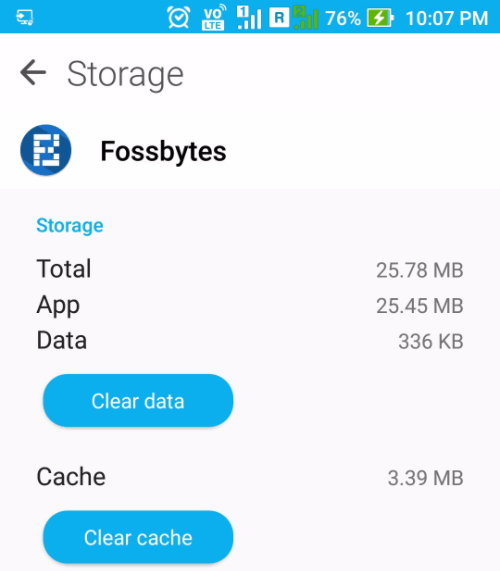
Sometimes clearing cached data can help make an application smoother as it removes old data that can lead to lag and lead to freezes and crashes. When data is deleted, the application can keep newer versions of the same things. This method is useful for large apps like Facebook and Instagram that store a lot of images and other data on your device.
Free advice for Android. Keep in mind that clearing the app cache in many cases will delete the settings saved by the app.
3. Clean the system memory several times throughout the day
Android has excellent task management skills. If necessary, it can close unwanted processes on its own. But this thing is old school, I can tell you, it will help a lot if your device runs out of RAM.
Nowadays almost every launcher includes the option to free system memory. If not, you should consider installing a memory cleaner app. And here I'm not talking about apps that claim your Android phone is faster by performing real-time cleanup operations. And all they do is make the device even slower.
Clearing your smartphone's RAM can give you an instant performance boost as it closes various unwanted apps that hijack precious Android phone storage.
4. Use lighter versions of the applications if available.

Many of the popular applications, such as Facebook, Twitter, Messenger, Opera, have their own "lightweight" versions. These lightweight apps are often designed for entry-level smartphones and for users who want to keep things simple.
Using lightweight versions for apps can improve the performance of your Android phone. And they also truncate your data as this is one of the reasons why such applications exist.
5. Update your phone regularly
Each new version of Android has different performance improvements. So updating your device, if your vendor is kind enough to release it, can do wonders and speed up Android.
Alternatively, you can jump to custom ROMs for your Android device if you believe the device manufacturer built the phone and just forgot it existed. This is the case with Mi Pad, a friend of mine brought in over a year ago. Even though the device has hardware, it still runs Android KitKat. Please note that using custom ROMs generally falls under the category of Android performance recommendations for advanced users.
6. Don't update your phone too much.
Now this may sound a little unusual. The good thing is that your Android phone is up to date belongs to the Android tips and tricks that every user has to offer. But everything has a drawback. If your device is on a low storage tier and is several years old, upgrading to a newer version will require additional resources.
Device storage can even shrink to the point that it messes up with your daily life, and all you have is the new Android and a few essential apps. Because your phone doesn't have a place to store more apps.
7. Think before you install the app.
It has been nearly a decade since the introduction of Android, and the number of applications for the platform has now grown to millions. But of this myriad of apps and games, not all of them are developed by developers with good intentions.
Many Android apps are fake and want to take control of your device, steal valuable data and send it to their masters. For example, the System Update malware has resided in the Play Store for three years and has not been detected.
Google recently released the Play Protect tool to scan such apps. You can indirectly make your Android device faster with this option. However, before installing, you need to verify the authenticity of the unknown app, even if you download it from the Play Store.
8. Format your SD card to improve Android performance.
If you are experiencing frequent crashes on Android phones, corrupted SD may be one of the reasons. Formatting your SD card will not only remove unnecessary junk of files created by the Android system and various applications, but in the end it can lead to better performance.

9. Install update apps over Wi-Fi only
Many applications need to update themselves in the background to constantly update information or do other things like downloading files, photos, videos. Thus, turning off background data can make an Android device faster, to some extent.
This is because applications are prohibited from connecting to the Internet and using system resources. In addition, turning off background data for mobile networks can help you save your internet bills.
Also, if you want Google to not sync your device, you can turn off auto sync on your Android device. And turn off auto-update on Google Play by visiting Settings> Auto-update apps> Select Auto-update apps over Wi-Fi.
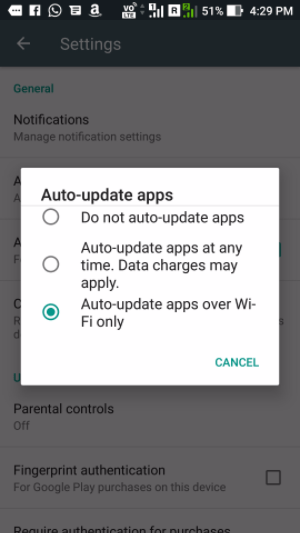
10. How to speed up the phone on android? - use the fingerprint sensor
Most Android phones now include a fingerprint sensor. Now, using the same will not improve the performance of your device. But, of course, it will reduce the time it takes to unlock the device. On average, fingerprint sensors can unlock your Android phone in about 0.5 seconds. The time can be 5 to 8 seconds in case of contacts.
11. A simple restart is what your Android phone sometimes requires

This applies to our computers; restarting machines can help them get through tough times. Likewise, it can happen with Android devices. When you restart your device, it deletes temporary files to speed up Android and also clears up your phone memory.
12. Keep your belongings in the cloud, free up your internal memory

The new way of 2017 storage is uploading files to the cloud. This not only makes our data available across devices, but also frees up valuable internal storage on an Android phone that can be used by applications installed on the device. Keep in mind that internal storage plays an important role in the performance of your Android phone.
13. Don't put too much stuff on the home screen
Filling your Android home screen with live wallpapers and tons of widgets sounds good. But under the hood, all of these things put additional strain on the hardware and affect the performance of the device.
At times, you may have seen your Android device try to load home screen content when you are using a heavy application or games.
Keeping your home screen as clean as possible can be one of the many ways to speed up your Android phone. It doesn't have to download all of the content every time you return to your home screen, or you can take your device to sleep.
14. Install applications to internal memory
Smartphones with little internal memory would gasp just after hearing this. But having around 16GB of internal storage is pretty standard, even in the case of many budget Android phones.
The reason I tell you to install apps on internal storage is that it is significantly faster and more reliable than most external SD cards. This is probably one of the reasons why premium smartphones like the iPhone and Pixel don't have an SD card slot. Device security is another important reason to cut out the slot though.
Both SD cards and internal memory are flash memory, but compatibility plays a significant role here. Not to mention the type of SD card used, be it UHS-I, UHS-II. UHS-II or later UHS-III card may be faster than internal memory.
Storage companies like SanDisk are currently working to create SD cards that can match internal storage and make Android faster and more efficient. However, internal storage is better in most cases.
15. Try other launchers made for Android
Custom launchers are a great way to turn your Android device into a brand new version. A custom launcher may not be able to provide significant hardware performance improvements, but some use a lot less memory and CPU than others. So, installing a lightweight custom launcher can make your Android phone faster.
What's more, a range of shortcuts, settings and other options can help you quickly manage your Android device, if not, make it faster. These apps can reduce the time people are likely to spend searching for various apps and settings on their phone.
16. What if your Android phone freezes up?
Difficult to digest, but some evil apps and processes cause our device to experience the temperatures of hell. But repeatedly tapping the screen or pressing buttons will only make things worse when your Android freezes due to an app crash or when all RAM is consumed.
Try to show some calmness and sophistication during these situations. In most cases, this is just an app and pressing the home button will take you to the home screen. After that, to speed up Android, you can kill the affected app from the Recent Apps section.
If nothing happens when you press the Home button, gently press the Power button and try Restarting or Turning off your device. You can remove the battery if the device is stubborn enough to refuse to restart. Can you have all the time if your smartphone has a non-removable battery, because you will have to wait for the battery to run out.
17. The roots of your Android
Does an Android device boost your Android's performance? No, it’s not like that. This is because rooting is not about sprinkling some holy water to achieve incredible performance gains. In fact, what you do after rooting your Android can make the device faster, or worse, it can slow down if you do something wrong. Note that rooting is part of Android's advanced tips and tricks; so be careful.
Most users shorten their virus removal devices - applications preinstalled on the phone - that cannot be removed directly. Gaining a solid understanding of the Android system can allow you to terminate processes that only burden the system.
You can even try some custom ROMs. If you remember, CyanogenMod was one of the features of the popular ROM with its current descendant in the name of LineageOS. There are other popular ROMs that can have a significant edge over the storage device on your device.
Note. Correcting the device will void the warranty.
18. Make Android Faster with Developer Options
There is a very popular way to make your Android device faster by changing some options in the developer settings. However, I personally don't like this suggestion as it comes out of the device without any special effects.
You can enable developer options on Android by going to About and hitting the build number five times in a row. Then you will be able to see the developer options in the settings. You can turn off animations on your device. Set the window animation scale, transition animation scale, and animator duration scale.

This change reduces the time it takes to render various visual effects on the screen while you work, making it run faster in a way. Go ahead if you're fine if your device is running ten-year-old software if it isn't.
19. Reset Android phone.
Last but not least, the ultimate option to speed up your Android phone is to perform a factory reset. You may want to consider this if your device has slowed down to a level that it cannot do basic things.
There are two ways to reset to Android device. First of all, visit Settings and use the factory reset option. This will soft reset your device, which involves resetting your device and wiping out all data like your photos, videos, apps, cache, etc.
For a deeper cleanup, you'll have to boot into recovery mode and restart your device. After turning off your phone on most Android devices, recovery mode can be accessed by pressing the Power and Volume Down buttons for about 5-10 seconds.
However, you should stick with the first method most of the time, as it will correct the situation for you. And don't forget to back up your data before doing anything.
So, these were some of the Android tips and tricks for your phone with the hope that you can give it some adrenaline rush.
Did you find this post in Android Tips and Tricks to make your Android more responsive? Let us know in the comments below.
Want to speed up your Android? Tired of the brakes and long responsiveness of apps? Before you decide to buy, you should first try to speed up your Android a little.
Let's try some tricks and speed up our device - including general cleaning, uninstalling apps, and some cool tricks and hacks.
Update the firmware on Android
The first thing to do is to make sure your device has the latest firmware. From time to time, a new version of Android comes out, a launcher and patches that fix errors. Any of the above can help speed up your Android.
To find out if your phone needs an update, go to "Settings" -> "About phone" -> "System update".
It is worth checking systematically for updated applications - especially applications such as emulators. The same goes for Google Play services as they control almost everything on your phone.
Installing custom firmware on Android
If there is no update for your smartphone for a long time, you can try solve the problem by installing custom firmware.
Usually such firmware has community-created mods that increase performance or add new features. Another custom firmware can update your device to the latest version of Android, even if your device is not officially supported.

This creates an inherent risk. You will need one that can kill your device. Some applications (for example, banking - Sberbank) will not work. The device may void the warranty. However, if you are confident in your technical skills or you have an old device, this method will give new life to the old gadget and really speed it up.
Clean up your Android desktop
Everyone cleans their house from time to time. The same applies to your Android device. If you have widgets on your desktop that show you news, weather, social networks. You may notice little slowdown when moving between tables. If you have visualizations like Bixdy turned on, consider turning it off..
If you do not go or are afraid to manually clean the cache, you can use a special application, for example CCleaner.
Disable auto sync Android
If you have a relatively new and modern phone, chances are it works well and quickly. But then one day you noticed a slowdown, especially when downloading and installing new applications.

The culprit for this is usually app sync. Find in "Settings" your phone item "Accounts" or "Synchronization", go into it and see that the function "Automatic data synchronization" included. Select the application in which you want to disable or change the settings.
Answer yourself to the question whether you need the application to sync every half hour, or if one sync per day will be enough.
Background processes in Android
Consider disabling and removing unnecessary background processes. Background processes are applications that constantly run in the background. For example, the Messages app is constantly running in the background to receive messages. But sometimes in the background I run applications that you practically do not use, and at this time they load the processor.

If you have exited, then go back to the "For Developers" section and find "Background Processes". Here you will see which applications are running in the background. Disable the ones you don't need and your phone will run a little faster. It will also have a good effect on the battery life.
Avoid optimization apps on Android
Android devices manage their memory very efficiently - it often happens that after closing the application they continue to work. Launching a new application takes longer and increases the load on the battery than one that was already launched and simply closed. When you open an application, and it runs out of memory, Android automatically closes the less important ones to free up space.
The app for automatically closing apps actually slows down your device and drains your battery.

For this reason, using "optimizers" actually slows down your device, rather than speeding it up. If you notice that they have helped you in the past, I assume that one or more applications are poorly optimized by the developers. The best way to find the culprit and try to replace them with normal ones or remove them.
The same goes for caching data - clear the cache from time to time, but don't overuse it!
Overclocking Android
If you need to speed up your game speeds, overclocking is the right solution.
Overclocking Is a proven way of maximizing productivity used by gamers on computers. This method works great on smartphones as well, provided you have root and a good overclocking application.

But this carries a certain risk. Smartphone manufacturers put limits on the clock speed of the processor to prevent overheating, high battery consumption.
Naturally, don't forget to check the settings menu of the games themselves! Lowering the graphics settings can often increase the smoothness of games and increase battery life.
Delete everything clean
If all else fails and you feel like your phone has become lagging a lot, one of the last methods is a simple factory reset. This will delete all files and settings that are slowing down your smartphone's speed and hopefully your phone will work like new again.
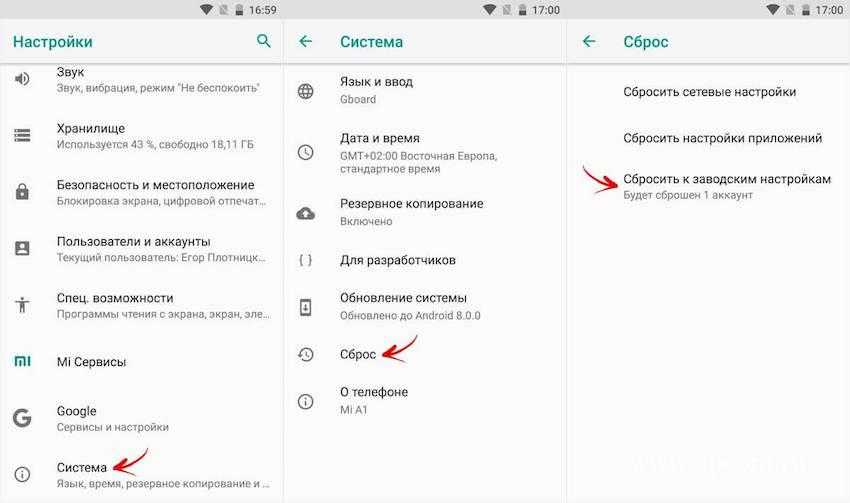
After the reset, just use all the tricks I have listed on a clean phone and you should be able to get the smartphone with maximum performance.
Did I miss something?
If I missed one or two ways to speed up an Android phone, be sure to tell us about them in the comments below, and my readers will be very grateful to you! Good luck!
13.09.2016 Frenk 3 comments
With phones and tablets running Android 4, 4.0, 4.1, 4.1.1, 4.2, 4.2, 2, 4.4, 4.4 2, 5.0, 5.1 or even 6.0, like 20 years ago with Windows.
Android works great when fresh and has enough memory. The problem begins within a few months.
Instead of being fast, we often have to wait for Android to download app updates.
This is the scourge of everyday life for many owners of smartphones, tablets and phones. But you can fix it.
I offer 8 proven ways to speed up android devices - improve performance.
Speed up android by limiting the number of installed applications
Let's start by checking the number of programs installed on your android device - if you really need them all.
With 100 applications, the memory is already getting seriously clogged. When the system has less than 500 MB of free space, the situation becomes dramatic.
Then the phone or tablet is slow. Experience shows that it is best when the main memory has more than 700 MB of free space.
Speed up android devices by moving apps to SD card
After removing unwanted applications, move all programs that offer this capability from your phone to flash memory.
This routine effectively cleans up the core memory, but unfortunately cannot be applied to all applications that tend to be Memory.
Speed up your phone / smartphone / tablet by system update
To ensure the stability and security of your tablet, phone or smartphone, always update the system software versions whenever possible.
Therefore, if this appears, you must install it. Owners of inexpensive tablets should pay special attention to updating the firmware of the operating system.
- By the way, you can also significantly increase the battery life on android devices.
In many cases, this solves many problems. The worst situation, unfortunately, is for users of phones with a version of the software prepared for a specific operator, since the new version of the system will have to wait much longer than the owners of non-branded equipment.
So, for example, Android 4.3 in Samsung Galaxy S3 combines system memory and internal memory and thus solves most of the problems with this.
Speed up android by disabling automatic updates
In most cases, Android can update automatically, but this is not always desirable.
When we have more than 100 applications, instead of working, we can wait continuously, because nothing wants to work.
This is not surprising when the system automatically updates several programs almost constantly.
The solution is to turn off automatic updates and start them manually, for example, once a week when you are not using your device.
Take care of free space
It is the only application that specializes in clearing the cache of individual programs.
This is especially useful when Android tells us that there are too few system resources left.
The program is complemented by the "Eraer" tool, which cleans the history of web browsing, applications, maps, SMS, and search history on YouTube or Google.
You can also use the 1-click cleaner app, which allows you to get rid of unnecessary temporary files, SMS, history, chat, video watching, etc. with one click of a button.
Speed up android by removing viruses
When Android slows down and starts to glitch, there may be signs of a virus infection.
Therefore, in the case of devices that include a SIM card, it is recommended to use the free security package at all times.
Since there is a risk that we will lose not only data, but also money, specialized viruses send expensive SMS without our knowledge.
Speed up android devices by minimizing active widgets and processes
The next step is to keep the programs running in the background to a minimum.
Most of them start working when the system starts up. You have no reason to waste your phone resources in the background playing games.
A proven solution is to use the Startup Manager application, which in the test smartphone was able to reduce the number of programs running in the background from 30 to 10.
Speed up android by unlocking the potential of your phone
Unfortunately, useless programs pre-installed with the help of the operator and cannot be removed can take up space in the device.
The only way to get rid of them is by changing the software. It is not difficult, but depending on the operator, it can lead to a violation of the warranty. However, it should be remembered that this process is reversible.
It is hard to argue with the fact that after changing the software to a clean one issued by the manufacturer, this can have an impact on mechanical damage.
The part of the app to improve the performance of tablets and smartphones needs to work to grant system access rights.

